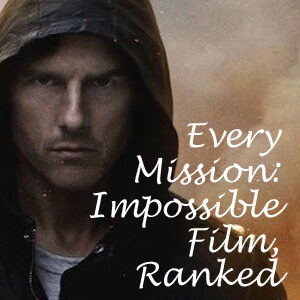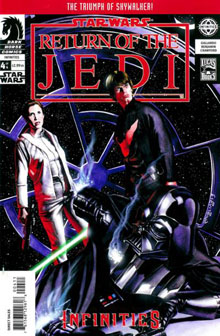After imaginative “Infinities” yarns from Chris Warner (“A New Hope”) and Dave Land (“The Empire Strikes Back”), the series concludes with Adam Gallardo’s relatively disappointing four-issue “Infinities: Return of the Jedi” (2003-04). Despite the two previous installments going beyond the constraints of the film in each title, Gallardo’s “Infinities” entry is constrained by the narrative structure of the actual “Return of the Jedi.”
Gallardo’s alternate timeline starts when Jabba the Hutt angrily slaps Threepio during the negotiation with Boushh. In the movie, Threepio recovers and continues to translate the exchange. In “Infinities: Jedi,” the droid’s head goes flying off and Jabba says “I can’t understand a word (Boushh is) saying. Get rid of this scum.” This forces Leia to take her helmet off; a Gamorrean guard shoots her, sending the thermal detonator flying; and everyone scrambles out of the palace, including Boba Fett with Han’s carbonite slab.
With this lame starting point, it shouldn’t be surprising that “Infinities: Jedi” never lives up to the grand ideas of its predecessors, which featured the proton torpedo failing to blow up the Death Star and Luke dying on the plains of Hoth.
Because everyone’s timing of getting from Tatooine to Sullust to Endor is thrown off a little bit, it turns out that both Luke and Leia confront Vader on the Death Star and they turn him to the light side before the Emperor mounts a Force-lightning attack. The Emperor then slinks off. This leads to a final striking image of Darth Vader in all white telling Rebellion officials “I may be of some use in locating my former master.”
Rather than the ending, this should’ve been the starting point of “Infinities: Jedi,” with the narrative delving into the question of how the Rebel Alliance would treat the White Knight Vader. I think it’s likely that they would try him for crimes against civilization, and this could’ve led to debates about how much they should allow Vader to assist in hunting down the Emperor — I see “Heir to the Empire’s” Borsk Fey’lya coming into the picture as the political gamesmanship ensues. Then if Vader succeeds in his mission, would the Alliance still execute him for his crimes, or would they determine he balanced the slate by killing Palpatine? I think Vader would accept punishment for his crimes, but he would want to see Palpatine killed first.
Also, forgiveness from Leia – not as quick to forgive as her brother — would be important to Anakin. Kathy Tyers is the only author to explore Anakin’s feelings post-death, in a scene in “The Truce at Bakura” (page 145 of the hardcover) where Anakin’s ghost visits Leia and asks her for forgiveness. She declines, citing Alderaan’s destruction and Vader’s torture of Han. Would Leia have reacted more like Luke if she too had been in the throne room when Vader turned back to the light?
“Infinities: Jedi” also delivers a truncated, flawed arc of Han Solo dealing with permanent blindness from his hibernation sickness (in this version, the controls on the carbonite block get damaged by a stray blaster bolt). It’s been established in the Expanded Universe that cybernetic eyepieces are available for people whose eyes are damaged (see Valance from Marvel’s “Star Wars” or Skorr from the Goodwin/Williamson strips). While not as advanced as the GFFA’s prosthetic limbs, it seems that Han could’ve regained his vision to some degree. Gallardo also opts not to use “Infinities: Jedi” to kill off Han, something that Harrison Ford advocated for back in the day.

“Infinities: Jedi” includes at least one concept fans might wish was in the movie: More Boba Fett action. The only flaw is that Fett’s arc is a repeat of the bounty hunter’s actions in “Empire”: Fett intends to sell Han-in-carbonite to the Imperials so they can use it as a trap to lure Leia and Luke for Vader’s purposes. In “Infinities: Jedi,” on an unnamed forest world, Leia, Chewie and Lando confront Fett and kill him, thus rescuing Han. I have my suspicions that Gallardo wanted this planet to be Endor before deciding that it wouldn’t fit with the narrative.
While there were plenty of logical reasons for the two-hour film to focus on Luke and Vader at the expense of Leia, Han, Boba Fett and other characters, it’s fun to think about paths not taken. “Infinities: Jedi” is consistently shallower than its two predecessors in the series because it’s unable to break free of the path already taken.

